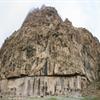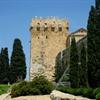In archaeology, excavation is the exposure, processing and recording of archaeological remains. An excavation site or "dig" is a site being studied. Such a site excavation concerns itself with a specific archaeological site or a connected series of sites, and may be conducted over as little as several weeks to over a number of years.
Archaeological excavations
-
 6
6Archaeological Sites of Bat
The Archaeological Sites of Bat, Al-Khutm and Al-Ayn are an important group of necropolises from the 3rd Millennium BC.
-
 7
7Atapuerca Mountains
The Atapuerca Mountains is an ancient karstic region of Spain, in the province of Burgos, Castile and Leon and near Atapuerca and Ibeas de Juarros.
-
 7
7Behistun Inscription
The Behistun Inscription is a multilingual inscription and large rock relief on a cliff at Mount Behistun in the Kermanshah Province of Iran, near the city of Kermanshah in western Iran.
-
 6
6Bishapur
Bishapur was an ancient city in Iran on the ancient road between Persis and Elam. The road linked the Sassanid capitals Estakhr and Ctesiphon. It is located south of modern Faliyan in the Kazerun County of Pars Province, Iran.
-
 7
7Colonial forum of Tarraco
The colonial forum of Tarraco is an ancient Roman archaeological site located in the modern city of Tarragona in Spain.
-
 10
10El Fuerte de Samaipata
El Fuerte de Samaipata or Fort Samaipata, also known simply as "El Fuerte", is a Pre-Columbian archaeological site and UNESCO World Heritage Site located in Santa Cruz Department, Florida Province, Bolivia.
-
 10
10Mada'in Saleh
Mada'in Saleh, also called Al-Hijr or Hegra, is an archaeological site located in Province of Al-Madinah in the Region of the Hejaz, Saudi Arabia. A majority of the vestiges date from the Nabatean kingdom (1st century AD). The site constitutes the kingdom's southernmost and largest settlement after Petra, its capital.
-
 10
10Pasargadae
Pasargadae was the capital of the Achaemenid Empire under Cyrus the Great who had issued its construction (559–530 BC), it was also the location of his tomb. It was a city in ancient Persia, located near the city of Shiraz, and is today an archaeological site and one of Iran's UNESCO World Heritage Sites.
-
 10
10Provincial Forum of Tarraco
The provincial forum of Tarraco is a Roman archaeological site in Tarragona, Catalonia, Spain, encompassing an area of 18 ha.
-
 6
6Shahr-e Sukhteh
Shahr-e Sukhteh is an archaeological site of a sizable Bronze Age urban settlement, associated with the Jiroft culture. It is located in Sistan and Baluchistan Province, the southeastern part of Iran, on the bank of the Helmand River, near the Zahedan-Zabol road.
-
 7
7Takht-e Soleyman
Takht-e Soleyman, also known as Azar Goshnasp, is an archaeological site in West Azarbaijan, Iran. It lies midway between Urmia and Hamadan, very near the present-day town of Takab, and 400 km west of Tehran.
-
 7
7Tamgaly
Tamgaly is a petroglyph site in the Semirechye, Kazakhstan.
-
 5
5Thaj
The ruins of Thaj can be seen about 80 km west of Al-Jubail. It is a small village situated beside a dry lakebed generally known as "Sabkah".
-
 10
10Tiwanaku
Tiwanaku is a Pre-Columbian archaeological site in western Bolivia. The site was first recorded in written history by Spanish conquistador Pedro Cieza de Leon. He came upon the remains of Tiwanaku in 1549 while searching for the Inca capital Qullasuyu.
-
 10
10Zubarah
Zubarah, also referred to as Al Zubarah or Az Zubarah, is a ruined and deserted town located on the north western coast of the Qatar peninsula in the Madinat ash Shamal municipality, about 105 km from the Qatari capital of Doha.


